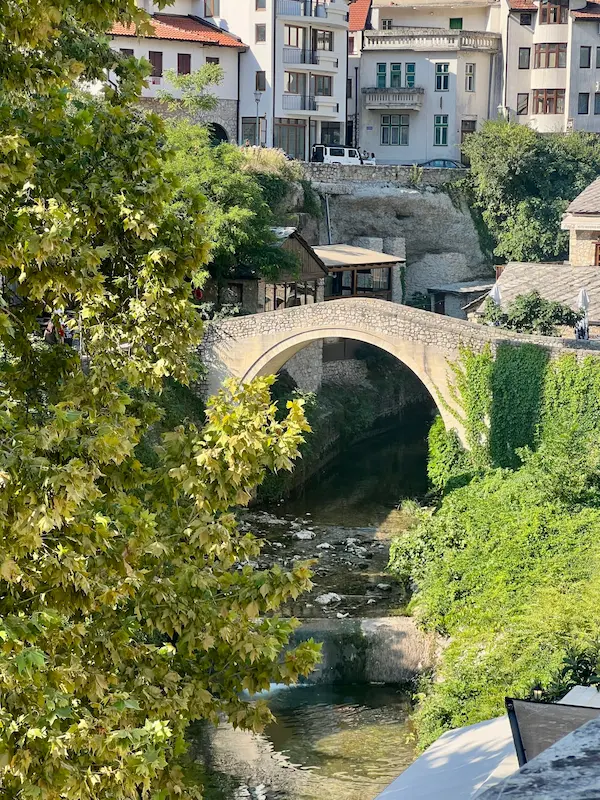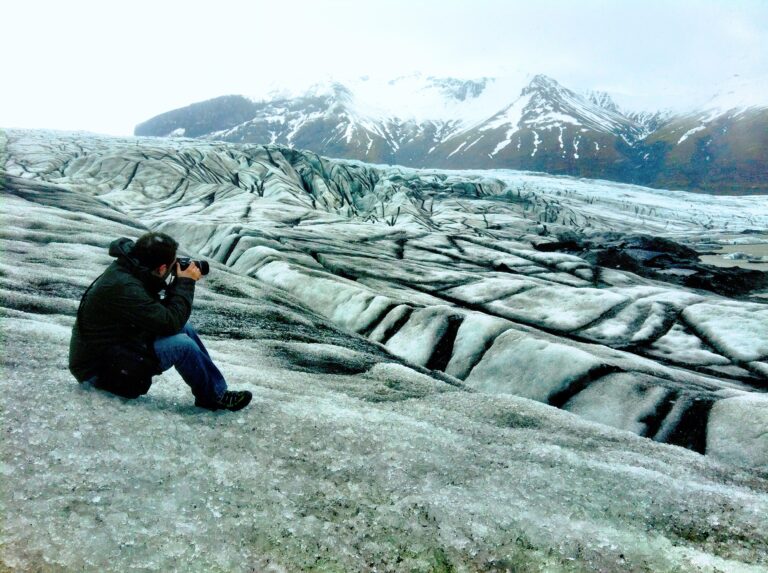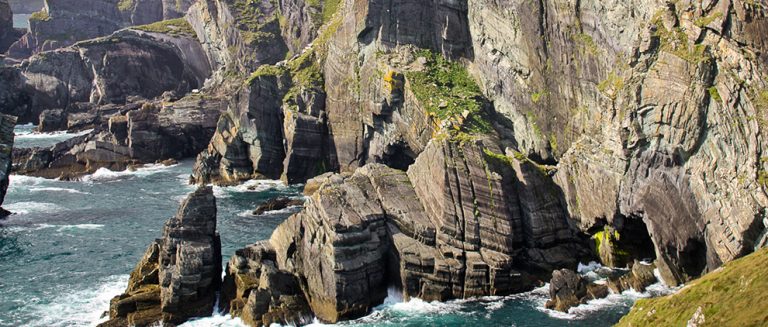Mostar & Banja Luka: Guider for Europe’s Hidden Gems
Visit Mostar travel guide: iconic Stari Most, old bazaar, day trips to Blagaj and Kravica; plus Banja Luka highlights.
Contents
Stage 7: Journey through the Balkans.
The Road to Mostar
Early in the morning, we left Sarajevo and took the bus from the Sarajevo bus station to Mostar. The bus journey takes around 3 and a half hours and is quite affordable (you can book it with FlixBus). Many suggested the train for its scenic route, but it was fully booked. Plus, you’d have to catch a very early morning train. Note to self: Plan your transportation ahead of time.
From the road, you’ll catch sight of some beautiful landscapes and a serene blue river. If you find yourself with some extra time, it’s definitely worth exploring (there are a few recommended waterfalls to check out around Mostar).
Our final destinations in this Balkan journey were Mostar and Banja Luka, where we’d catch our outbound flight from the balkans. However, we had a bit of a challenge finding public transport (bus) between Mostar and Banja Luka. When we arrived at Mostar bus station, we asked about other options and were pleasantly surprised to find out about daily buses that weren’t listed online. This solved our last city connection of the journey.
Arrival in Mostar
We planned a two-day stay in Mostar. We managed to find affordable accommodation close to the centre (Pansion Guma Mostar) providing easy access to explore the town. Our first order of business was to have a quick lunch and explore the city. We managed to find a place that was perfect for a quick lunch: Aščinica Balkan II. We tried the traditional Bosnian cuisine: Sogan Dolma (a delicious stuffed onion with meat, rice and spices) and Cevapi, grilled rolls of seasoned ground meat (a mixture of beef and lamb), served in pita bread.

The Heartbeat of Mostar – Stari Most
After Lunch, we walked towards the Old Mostar Bridge (Stari Most) and we realised that the city was hosting the Red Bull Cliff Diving competition, where participants were competing to dive from the bridge. The city was crowded due to this event and we spent the afternoon watching some of the impressive dives. The Red Bull Cliff Diving World Series is a notable event that takes place at Stari Most. The competition attracts world-class divers who showcase their skills by diving from the bridge into the river below.
While crossing the Old Mostar Bridge (Stari Most) we noticed the bridge stones were slippery, and some people had to walk with extreme caution to avoid slipping and falling.
Why is the Mostar Old Bridge now Known?
The old bridge in Mostar, known as Stari Most (Stari meaning old and Most meaning bridge, hence the name of the city Mostar, due to its bridges over the river Neretva), was originally built in the 16th century during the Ottoman Empire. It served as a vital crossing point over the Neretva River and is considered an exemplary piece of Balkan Islamic architecture. During the Bosnian War in the 1990s, the Mostar Bridge was heavily damaged and ultimately destroyed in November 1993, collapsing due to shelling by the Croatian Defence Council.
The destruction of Stari Most during the Bosnian War was a significant cultural and historical loss. After the war, efforts were made to reconstruct the bridge using traditional building methods and materials. Completed in 2004, the restored Stari Most now stands as a symbol of reconciliation and unity in a region that experienced ethnic and religious tensions during the conflict. To preserve authenticity during the reconstruction, traditional building materials and methods were employed, with many stones sourced from the same quarry that provided the original ones centuries ago.
We continue our visit to Mostar, exploring further visiting key places but I suggest joining a free tour to better understand the city’s history. In Mostar, you will also observe how mosques, Orthodox and Catholic churches coexist together.
Must See places to see in Mostar
Stari Most (Old Bridge)
The most iconic landmark in Bosnia & Herzegovina, Stari Most is a symbol of the region. The Old Bridge in Mostar is probably the most famous and most photographed place in Bosnia and Herzegovina, this bridge is a must-visit landmark in the Balkans. Check out different viewpoints like the minaret of Koski Mehmed-Pasha Mosque (a bit overpriced in my opinion), or simply stroll from the Old Bazaar towards the Old Bridge where you’ll discover plenty of spots to admire the Stari Most. Another cool spot is from the Lučki Most bridge for different perspectives, and my personal fave is from the riverfront on the left side facing the bridge: the beach below Stari Most, near the Karma Cafe. Keep an eye out on the riverbank to spot old pieces from the Stari Most that were left when it was destroyed during the war.

The Crooked Bridge
Also known as the Kriva ćuprija (the Crooked Bridge), often overshadowed by Stari Most, this smaller bridge offers a quieter atmosphere. It is a bit hidden but just a few steps away from its more famous brother. It was built in 1558, eight years before the Old Bridge and it is an identical, smaller version of the iconic Mostar attraction. It was created as the prototype of the Old Bridge hence all the similarities. However, what you can see now is the rebuilt version of the bridge – the original one was destroyed during the flood in 2001.
Visit Koski Mehmed-Pasha Mosque
Many people visit this mosque just for the Minaret viewpoint of the Stari Most. But this mosque it is also one of the finest examples of Ottoman architecture in Mostar. It was built at the beginning of the 17th century. The interior is really nice, but in my opinion the entrance is overpriced. However, do not miss to walk in the patio.

Old Bazaar (Bazar Kujundžiluk)
This is the most touristic area of the city where you can walk through the cobbled streets of the Old Bazaar. And a great place to buy some souvenirs.

War scars in Mostar
You can also find some war damages still in Mostar as the city was badly hit during the 1990s War, with heavy fights in and around the city.
If you explore further beyond from the touristy area you will find destroyed houses and bullet holes on the walls. One of the building that is currently a symbol of the war in Mostar is the “Sniper Tower”. This building was the former bank and it was used as a shooting position for snipers.
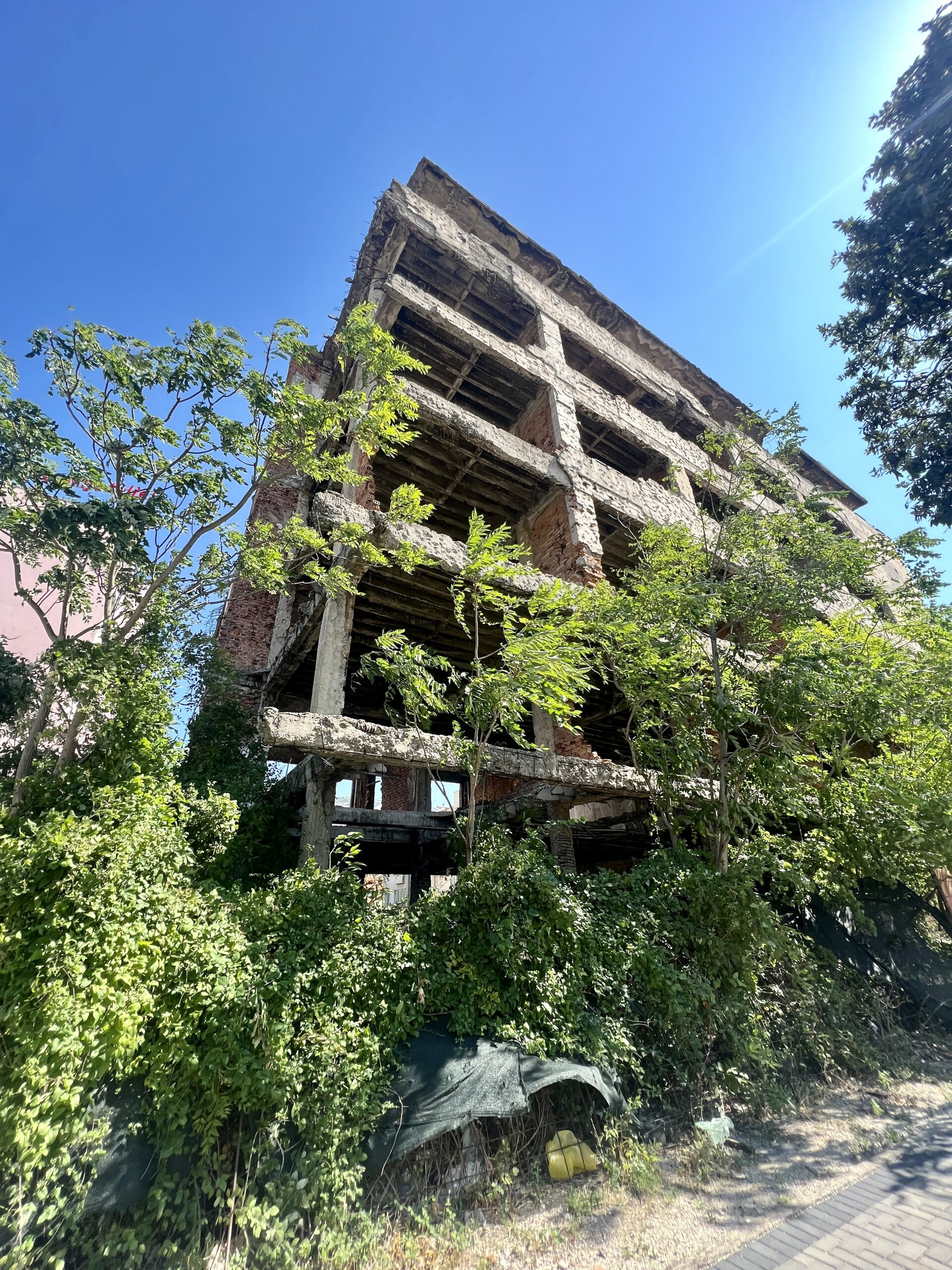
Adjacent stands the Spanish Soldier monument, honoring soldiers who lost their lives during the war. Spain’s post-war efforts in Bosnia and Herzegovina, including reconstruction projects and cultural preservation, underscore its commitment to peace and stability. United Nations Security, in 1992, authorized a multinational force for a humanitarian mission in Bosnia and Herzegovina. In 1995, Mostar’s main square was renamed Spanish Square in memory of 22 Spanish soldiers and their translator who lost their lives. Spain played a key role in Bosnia and Herzegovina after the war (1996-2008), aiding reconstruction, peace efforts, defense sector strengthening, refugee support, and economic sustainability.
Day tours outside Mostar
There are loads of companies doing day tours (like 12 hours long!) where you can check out cool spots near Mostar. You’ve got Blagaj with the Dervish house and Buna River spring, Pocitelj by the Neretva river, and the awesome Kravica Waterfall. Personally, renting a car and exploring on your own gives you a better experience. Plus, you could venture out to places a bit farther like Trebinjne. Enjoy the scenery!

Spending the day in Mostar
In our second day, after visiting the main landmarks of the city, we also attended the red bull Diving competition to see the progress and just relaxed by the river having some drinks. After all, this was almost the final stage of our travel through the Balkans.
Banja Luka: The Final City of Our Balkan Journey
Alright, so after spending two full days exploring Mostar, we hopped on a bus heading to Banja Luka. The bus ride takes about 4 or 5 hours, making a few stops along the way. This last stop was significant for two reasons: we wanted to visit the capital of the Republika of Srpska in Bosnia and Herzegovina and also because it is where you can find very cheap flights to fly out of the region towards western Europe.

Republika Srpska
I’ll use this chance to share a bit about the Republic of Sparksa and its origins (we also explored a part of the republic during our visit to Srebenica in our prevous stage of our journey).
Republika Srpska is one of the two main parts of Bosnia and Herzegovina (BiH), located in the Balkans. Bosnia and Herzegovina are not separate; the name covers the whole country and includes Republika Srpska and the Federation of Bosnia and Herzegovina. BiH is next to Serbia, officially known as the Republic of Serbia, distinct from Republika Srpska. Please note that “Republika Srpska” means Serbian Republic, but it’s a separate entity.
So, during our short day in Banja Luka and I was pleasantly surprised by the city’s size as it was bigger city than I expected. We attempted to explore Kastel Fortress but instead found ourselves walking around and also paid a visit to its distinctive mosque, Ferhadija.
It was nice to wallk through the city center and main square, where you’ll discover the Orthodox Cathedral of Christ the Saviour. The Cathedral’s interior is truly impressive and definitely worth a visit. Some areas of the city radiate a nostalgic ambiance from the communist era, while other parts showcase a charming fusion of Austro-Hungarian architecture.

A Parting Note
Our time was short, so we had to head to the airport. Just so you know, it’s not very convenient to get there from the city. Buses aren’t frequent, so plan ahead – it takes about 30 minutes.
This was our last stage of our Balkan Jouney for two weeks: starting in Croatia Capital, Zagreb, exploring Serbia and walking through Sarajevo and towns of Bosnia and Herzegovina . I can say that is totally worthy to spend time visiting this region in Europe with a lot of hidden gems through these countries and full of history to learn about. I hope that the last six post will be helpful as aninpiration for planning your trip in this region and peek your interest in visiting some of these off beaten path places.
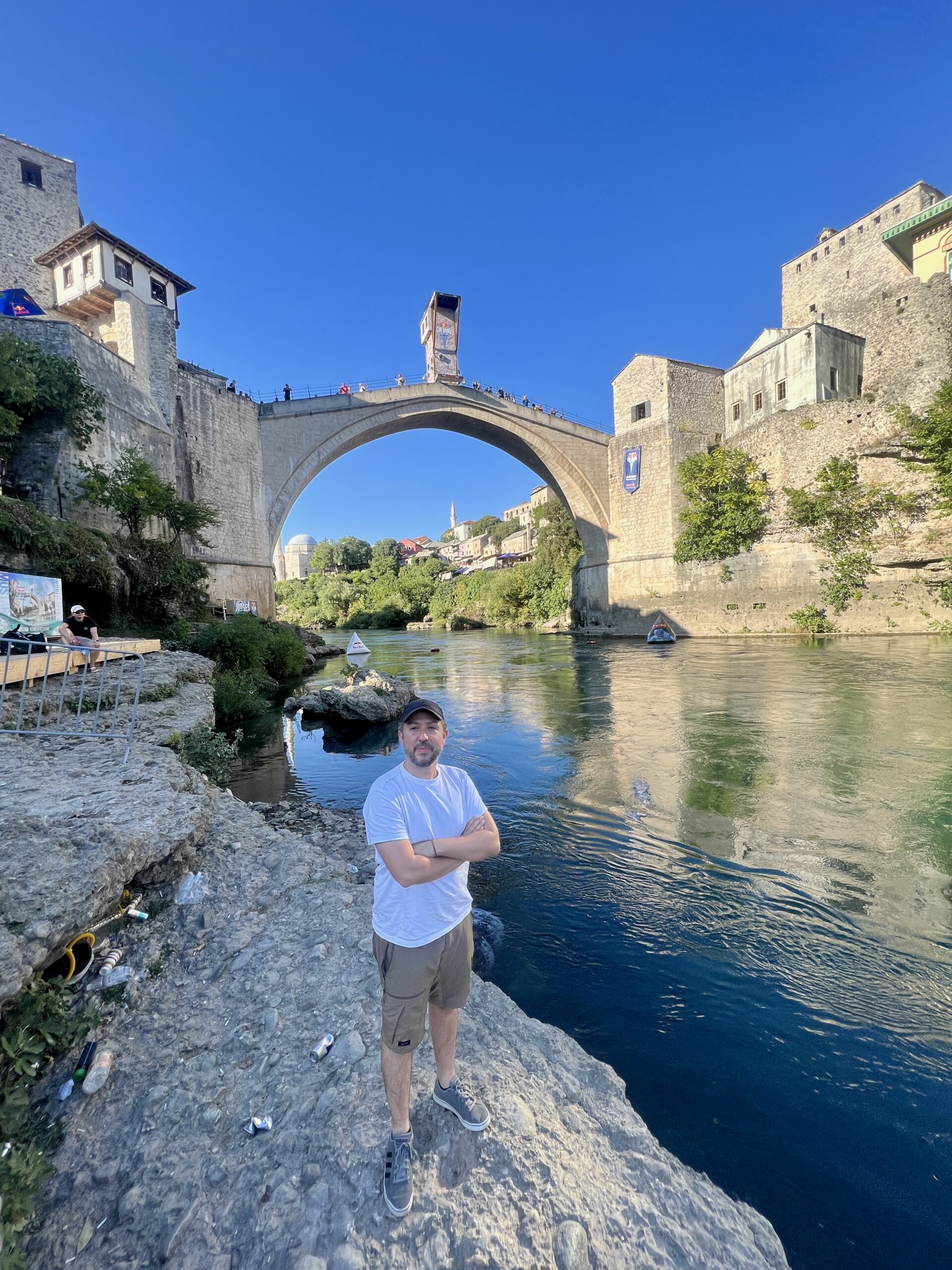
This was the final leg of our two-week Balkan Journey: starting in the Croatian capital, Zagreb, exploring Serbia, walking through Sarajevo’s historic streets and wandering through the lovely towns of Bosnia and Herzegovina. Visiting this region in Europe is definitely worthwhile, with many hidden gems waiting in these countries and rich history to learn about.
I hope that the previous six posts will not only serve as a source of inspiration for crafting your itinerary within this region but also spark your curiosity to explore some off the beaten path places listed on these posts.
Safe travels


